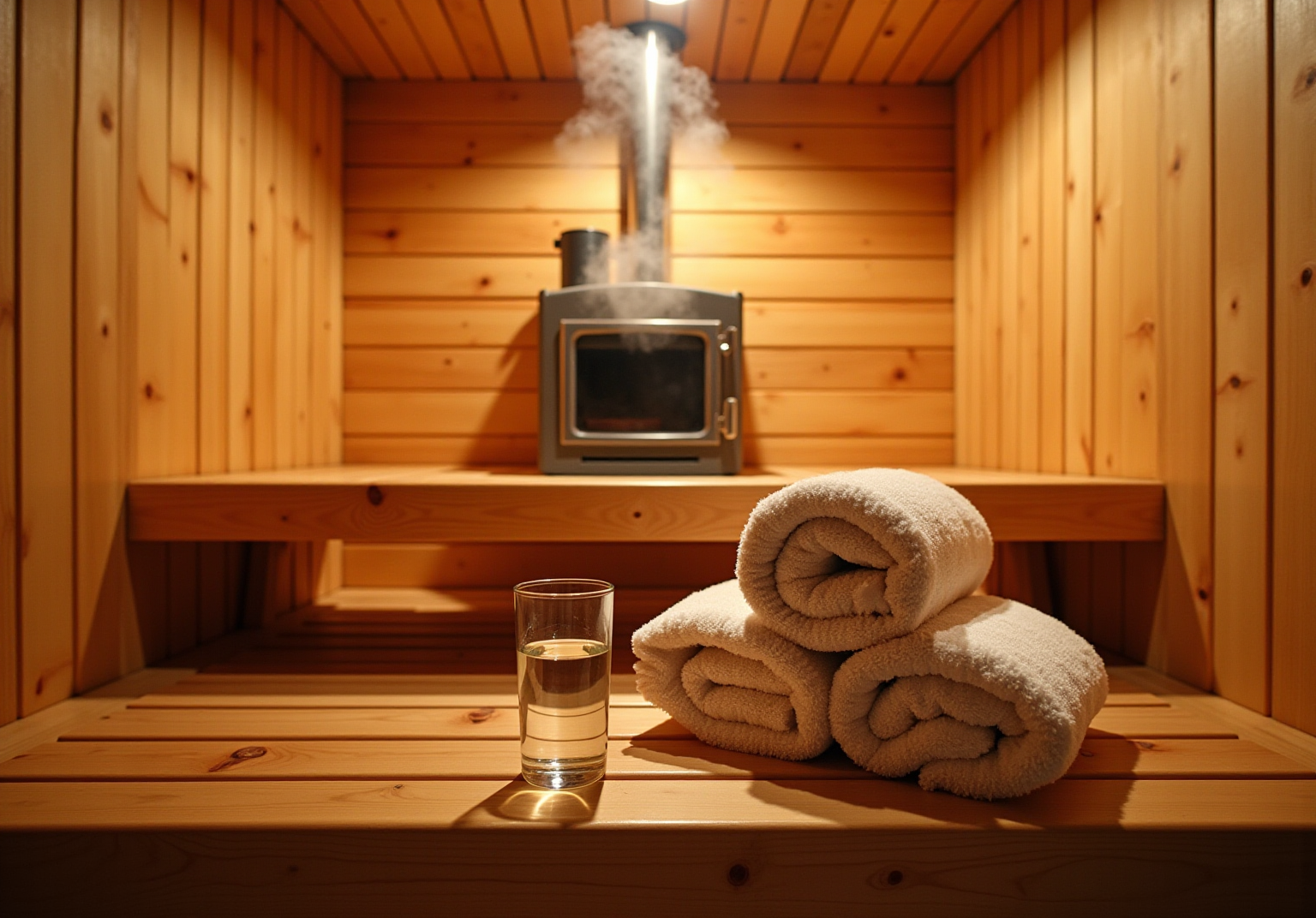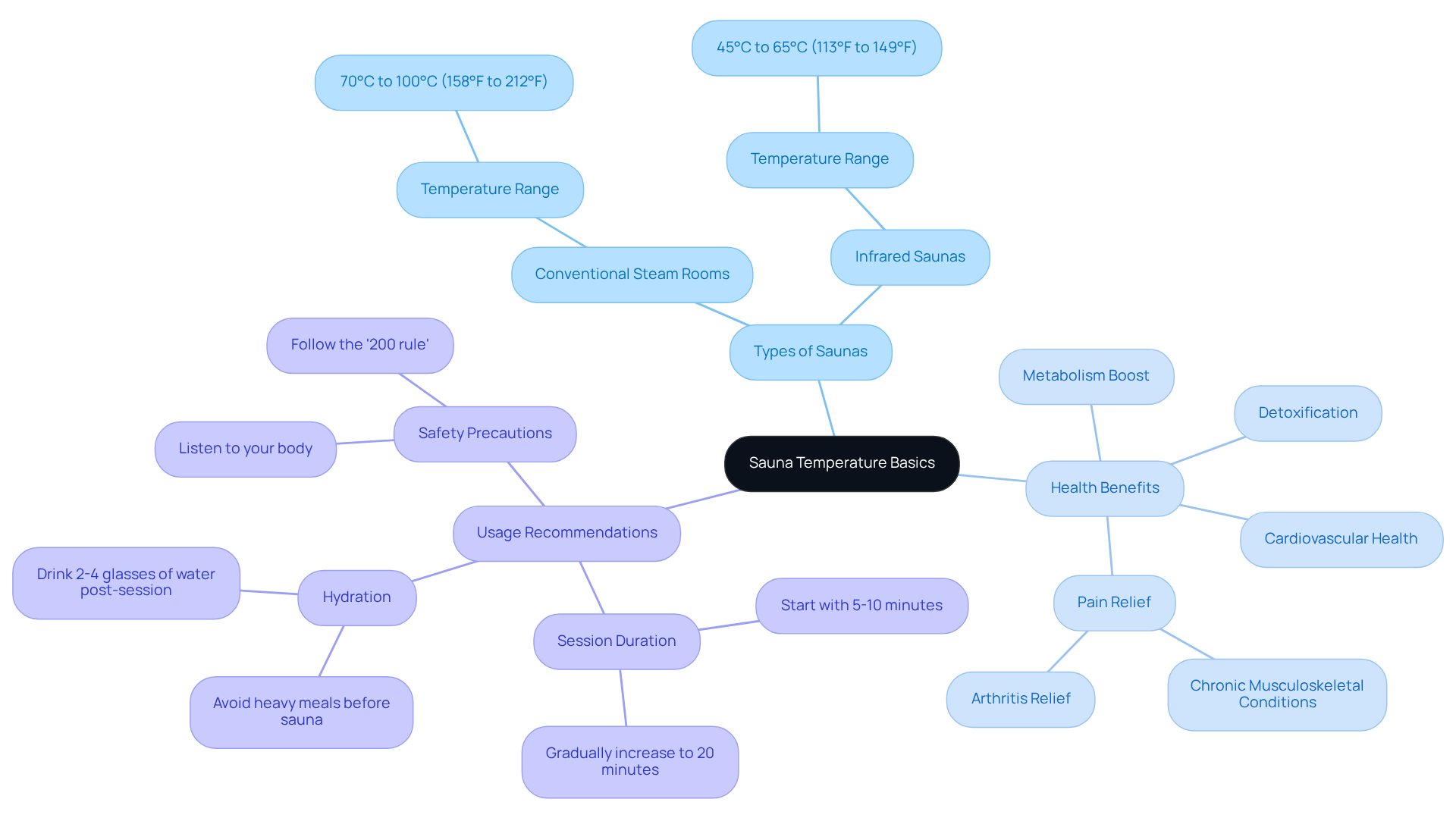How Hot is a Sauna? Discover Ideal Temperatures for Wellness

Overview
Saunas operate at temperatures ranging from 70°C to 100°C (158°F to 212°F) for traditional types, while infrared saunas function at lower temperatures of 45°C to 65°C (113°F to 149°F). Understanding these temperature ranges is crucial for maximizing wellness benefits, including:
- Detoxification
- Improved circulation
- Stress relief
Moreover, this knowledge ensures a safe and comfortable sauna experience. By recognizing the distinctions between sauna types, individuals can make informed choices that enhance their overall well-being.
Introduction
Saunas have long been celebrated for their ability to promote relaxation and wellness. However, many individuals remain curious about the optimal temperatures for these rejuvenating spaces. Understanding the ideal heat levels not only enhances the sauna experience but also unlocks a myriad of health benefits, from detoxification to improved circulation.
With various types of saunas, each offering distinct temperature ranges, determining the best choice for your personal wellness journey becomes essential. This exploration delves into the temperatures of different sauna types and their profound impacts on health, inviting readers to discover the perfect balance of heat and comfort tailored to their needs.
Understand Sauna Temperature Basics
Saunas create a controlled environment that harnesses heat to promote sweating and relaxation, prompting many to wonder how hot is a sauna. The heat inside a steam room can fluctuate considerably based on its type. Conventional steam rooms typically operate at high temperatures, ranging from 70°C to 100°C (158°F to 212°F), while infrared models, such as those offered by Tsavo Wellness, function at lower heat levels, generally between 45°C to 65°C (113°F to 149°F). Understanding how hot is a sauna and these temperature ranges is crucial for enhancing your experience, as each range offers distinct wellness benefits and comfort levels.
At Tsavo Wellness, the Full Spectrum Infrared Sauna delivers a unique experience where infrared light penetrates the skin and muscles, promoting intense sweating that supports detoxification, enhances metabolism, strengthens the immune system, and improves skin health and complexion. Additionally, opting for 20 minutes of red light therapy during your session can amplify these benefits, offering therapeutic effects that elevate the experience. When exposed to heat, the body responds by increasing heart rate and improving blood flow, resulting in numerous physiological advantages. Regular heat therapy use is linked to enhanced cardiovascular health, with studies indicating a significant reduction in pain severity for individuals with chronic musculoskeletal conditions.
For optimal results, it is recommended to start with shorter heat sessions of five to ten minutes, gradually extending the duration to about 20 minutes, while understanding how hot is a sauna to allow your body to acclimate and identify its comfort zone. Staying hydrated during your heat sessions is vital; consuming two to four glasses of cool water post-session aids in replenishing fluids lost through perspiration. Listening to your body is paramount; should you experience any discomfort, it is essential to exit the heat room and cool down. Furthermore, adhering to the '200 rule' for maintaining a balanced mix of heat and humidity can enhance your experience while minimizing the risk of overheating and heat stroke.

Identify Ideal Temperature Ranges for Different Sauna Types
Various types of steam rooms offer distinct optimal heat levels tailored to specific wellness benefits and personal preferences. Understanding these differences is crucial for making an informed choice.
When considering how hot is a sauna, it's important to note that traditional saunas operate at temperatures between 70°C to 90°C (158°F to 194°F), facilitating intense sweating that aids in detoxification, relaxation, and muscle recovery. Regular use can significantly enhance cardiovascular health and reduce symptoms of rheumatic conditions. Research indicates that consistent exposure to heat, particularly in terms of how hot is a sauna, correlates with a decreased risk of cardiovascular incidents, underscoring the importance of incorporating sauna sessions into your wellness routine.
Infrared Relaxation Rooms: At Tsavo Wellness, infrared relaxation rooms operate at lower heat levels, typically ranging from 45°C to 65°C (113°F to 149°F). These saunas penetrate deeper into the skin, offering benefits such as improved circulation, detoxification, and pain relief without the extreme warmth associated with traditional saunas. Many users find that temperatures around 50°C to 60°C provide optimal comfort and efficacy, making this an ideal choice for those sensitive to heat. The serene cedarwood environment further enhances the experience, promoting skin health and boosting metabolism.
Steam Rooms: Maintaining a cooler environment of 40°C to 50°C (104°F to 122°F) with high humidity, steam rooms are particularly beneficial for respiratory health and skin hydration. The elevated humidity enhances the steam room experience, making it suitable for individuals seeking relief from breathing issues.
When selecting a steam room, consider your wellness goals and personal comfort levels. Beginners should start at the lower end of the heat spectrum and gradually increase as they acclimate, ensuring a safe and enjoyable experience. Staying hydrated and monitoring your time in the steam room will further amplify the wellness benefits. Make the most of your steam room experience by prioritizing your health and comfort.

Explore Health Benefits Linked to Sauna Temperature
The advantages of sauna use are significantly influenced by how hot is a sauna. Understanding these benefits is essential for anyone looking to enhance their wellness routine.
-
Detoxification: Traditional saunas, with their higher temperatures, promote sweating, which aids in the elimination of toxins from the body. This detoxification process not only improves overall wellness but also enhances well-being, making steam room sessions an invaluable part of a comprehensive health strategy.
-
Enhanced Circulation: The warmth generated in steam rooms causes blood vessels to expand, leading to improved blood flow and circulation. This physiological response can contribute to better cardiovascular health and a gradual reduction in blood pressure over time.
-
Muscle Recovery: Exposure to heat is instrumental in relaxing muscles and alleviating soreness. For athletes and active individuals, steam rooms serve as an excellent recovery tool, facilitating quicker recuperation following intense physical activity.
-
Stress Relief: The serene environment of a steam room, coupled with the soothing warmth, can significantly diminish stress levels and foster relaxation, ultimately enhancing mental well-being.
-
Skin Health: Regular use of hot rooms can improve skin tone and texture by promoting sweating and increasing blood circulation to the skin, resulting in a clearer and more radiant complexion.
To fully harness these benefits, it is crucial to select the appropriate type and temperature, such as knowing how hot is a sauna, that align with your health objectives. Regular sauna sessions, tailored to your comfort level, can yield lasting improvements in both physical and mental well-being.

Conclusion
Understanding the ideal temperatures for various types of saunas is essential for maximizing wellness benefits. Saunas, whether traditional or infrared, operate within specific temperature ranges designed to cater to diverse health needs and personal comfort levels. By comprehending how hot a sauna can get and the unique benefits associated with each type, individuals can significantly enhance their sauna experience and positively contribute to their overall health.
Key insights reveal that:
- Traditional saunas typically reach higher temperatures of 70°C to 100°C (158°F to 212°F), promoting detoxification, relaxation, and improved cardiovascular health.
- Infrared saunas operate at lower temperatures, between 45°C to 65°C (113°F to 149°F), offering deep tissue benefits without the extreme heat.
- Steam rooms maintain cooler environments that are particularly beneficial for respiratory health.
The importance of hydration and gradual acclimatization cannot be overstated; these practices ensure safety and comfort during sauna sessions.
Ultimately, incorporating regular sauna use into a wellness routine can lead to significant improvements in physical and mental well-being. By understanding how sauna temperatures affect the body and aligning sauna practices with personal health goals, individuals can harness the full potential of this restorative therapy. Whether seeking stress relief, muscle recovery, or enhanced skin health, the benefits of saunas are profound and worth exploring. Embrace the heat and prioritize your health—your body will thank you for it.
Frequently Asked Questions
What are the typical temperature ranges for different types of saunas?
Conventional steam rooms typically operate at high temperatures ranging from 70°C to 100°C (158°F to 212°F), while infrared saunas function at lower heat levels, generally between 45°C to 65°C (113°F to 149°F).
What benefits does the Full Spectrum Infrared Sauna offer?
The Full Spectrum Infrared Sauna promotes intense sweating that supports detoxification, enhances metabolism, strengthens the immune system, and improves skin health and complexion.
How can red light therapy enhance the sauna experience?
Opting for 20 minutes of red light therapy during your sauna session can amplify the benefits, offering therapeutic effects that elevate the overall experience.
What physiological changes occur in the body during sauna use?
When exposed to heat, the body responds by increasing heart rate and improving blood flow, which results in numerous physiological advantages, including enhanced cardiovascular health.
How long should initial sauna sessions be?
It is recommended to start with shorter heat sessions of five to ten minutes, gradually extending the duration to about 20 minutes as your body acclimates.
Why is hydration important during sauna use?
Staying hydrated is vital; consuming two to four glasses of cool water post-session helps replenish fluids lost through perspiration.
What should you do if you experience discomfort during a sauna session?
If you experience any discomfort, it is essential to exit the heat room and cool down.
What is the '200 rule' in sauna use?
The '200 rule' refers to maintaining a balanced mix of heat and humidity to enhance the sauna experience while minimizing the risk of overheating and heat stroke.


